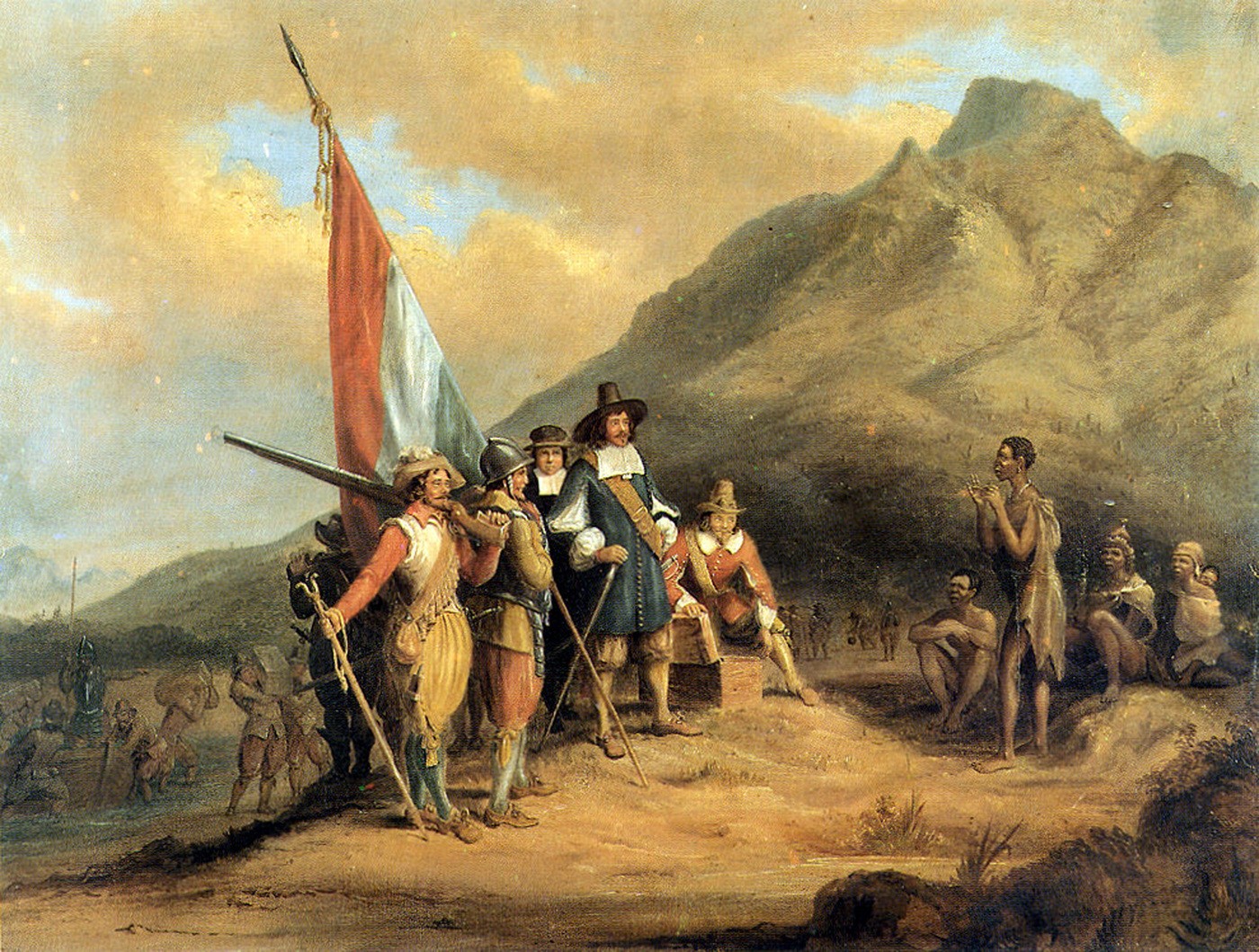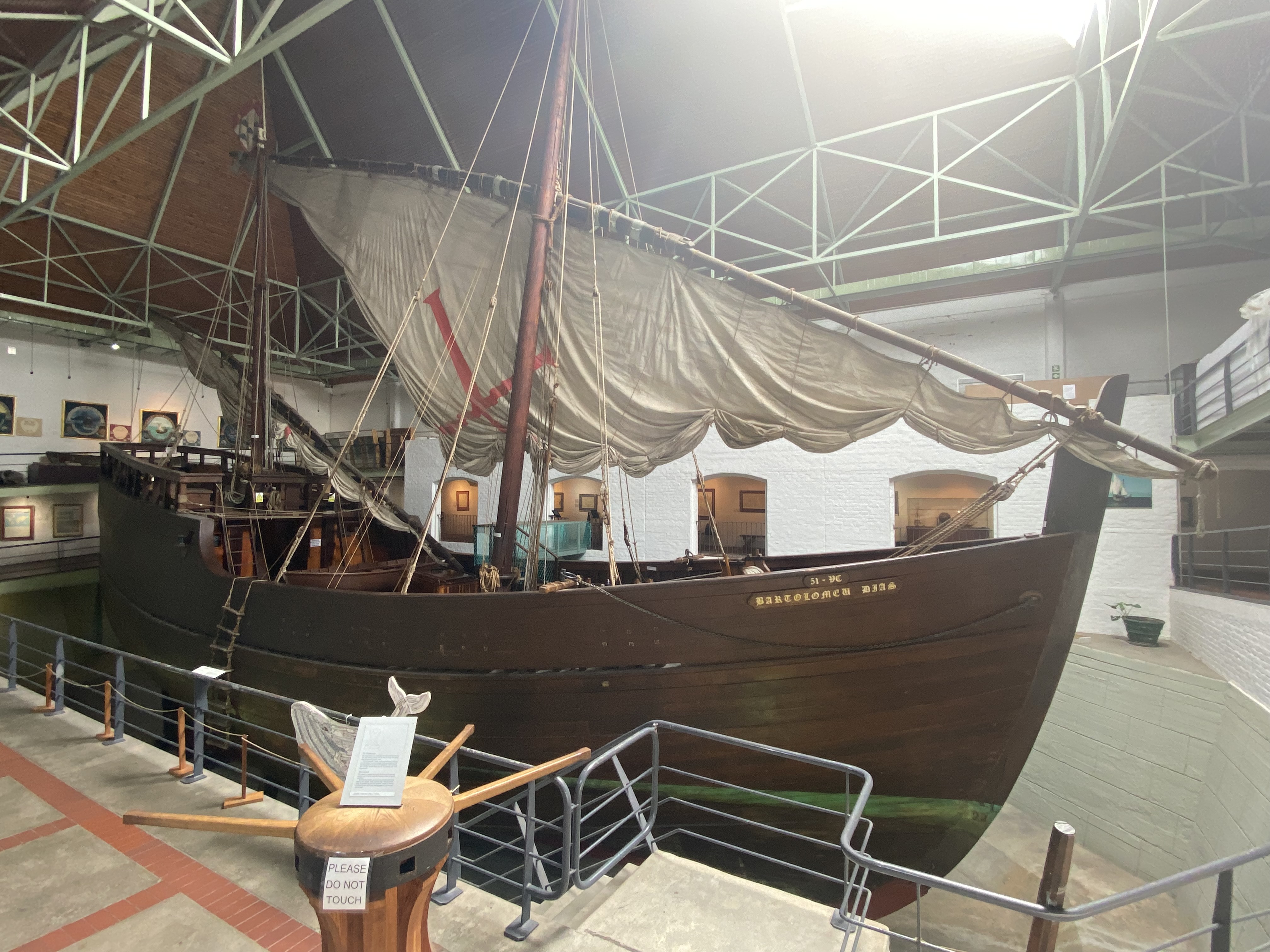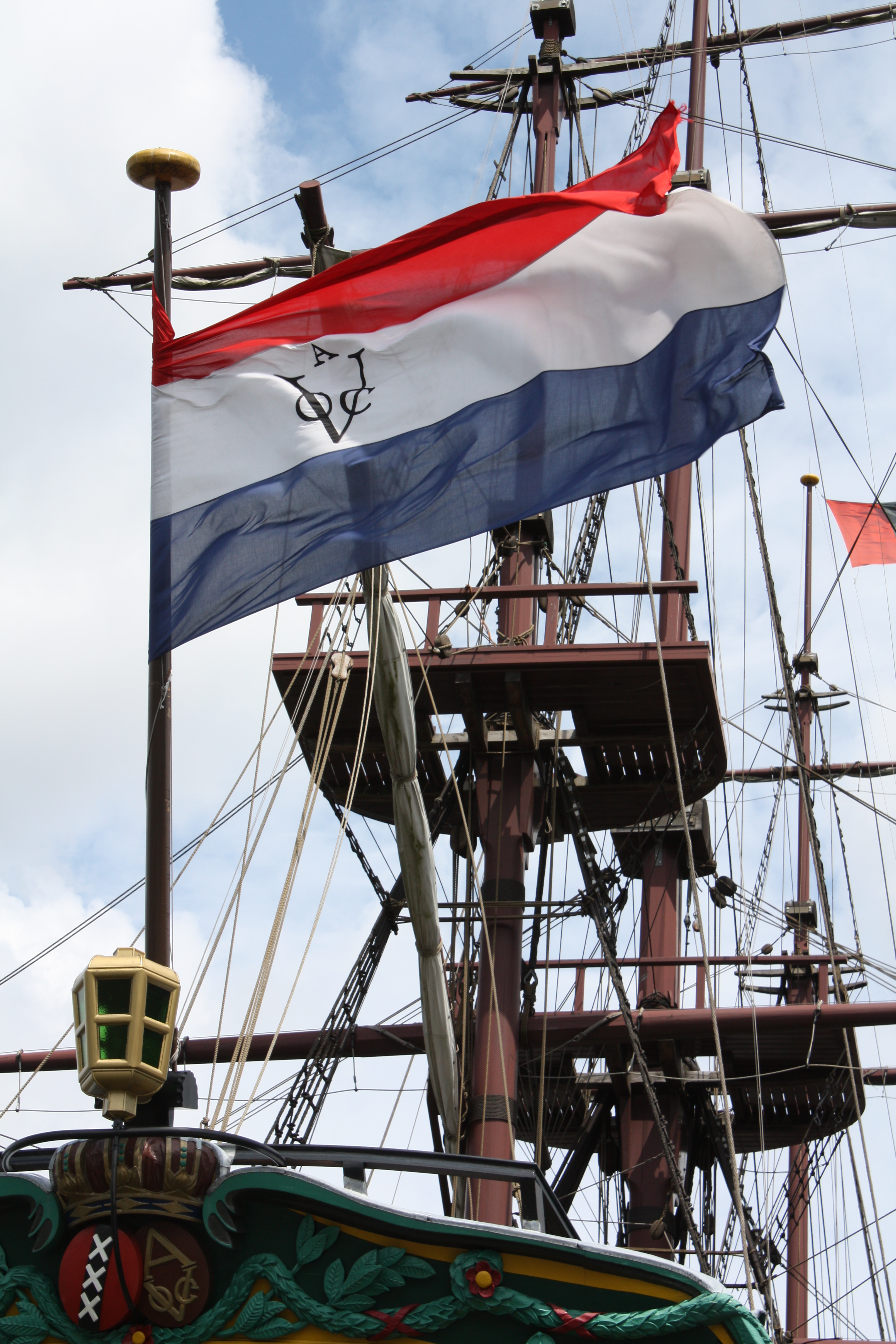|
History Of Cape Colony Pre-1806
The written history of the Cape Colony in what is now South Africa began when Portuguese navigator Bartolomeu Dias became the first modern European to round the Cape of Good Hope in 1488. In 1497, Vasco da Gama sailed along the whole coast of South Africa on his way to India, landed at St Helena Bay for 8 days, and made a detailed description of the area. The Portuguese, attracted by the riches of Asia, made no permanent settlement at the Cape Colony. However, the Dutch East India Company (VOC) settled the area as a location where vessels could restock water and provisions. First settlement The Dutch East India Company settlement in the area began in March 1647 with the shipwreck of the Dutch ship ''Nieuwe Haarlem''. The shipwreck victims built a small fort that they named the "Sand Fort of the Cape of Good Hope." They stayed for nearly a year, until they were rescued by a fleet of 12 ships under the command of W. G. de Jong. After their return to Holland, some of the shi ... [...More Info...] [...Related Items...] OR: [Wikipedia] [Google] [Baidu] |
Bartolomeu Dias
Bartolomeu Dias ( – 29 May 1500) was a Portuguese mariner and explorer. In 1488, he became the first European navigator to round the Cape Agulhas, southern tip of Africa and to demonstrate that the most effective southward route for ships lies in the open ocean, well to the west of the African coast. His discoveries were later used by Vasco da Gama to establish a sea route between Europe and Asia. Early life Bartolomeu Dias was born around 1450 in the Faro District of Portugal. His family had a maritime background, and one of his ancestors, Dinis Dias, explored the African coast in the 1440s and discovered the Cap-Vert peninsula in today's Senegal in 1445. Tracing his biography is complicated by the existence of several contemporary Portuguese seafarers with the same name. In 1481, Dias accompanied an expedition, led by Diogo de Azambuja, to construct a fortress and trading post called São Jorge da Mina in the Gulf of Guinea. Indirect evidence also points to his possible pa ... [...More Info...] [...Related Items...] OR: [Wikipedia] [Google] [Baidu] |
Dutch Language
Dutch ( ) is a West Germanic languages, West Germanic language of the Indo-European language family, spoken by about 25 million people as a first language and 5 million as a second language and is the List of languages by total number of speakers, third most spoken Germanic language. In Europe, Dutch is the native language of most of the population of the Netherlands and Flanders (which includes 60% of the population of Belgium). "1% of the EU population claims to speak Dutch well enough in order to have a conversation." (page 153). Dutch was one of the official languages of South Africa until 1925, when it was replaced by Afrikaans, a separate but partially Mutual intelligibility, mutually intelligible daughter language of Dutch. Afrikaans, depending on the definition used, may be considered a sister language, spoken, to some degree, by at least 16 million people, mainly in South Africa and Namibia, and evolving from Cape Dutch dialects. In South America, Dutch is the native l ... [...More Info...] [...Related Items...] OR: [Wikipedia] [Google] [Baidu] |
Boer
Boers ( ; ; ) are the descendants of the proto Afrikaans-speaking Free Burghers of the eastern Cape frontier in Southern Africa during the 17th, 18th, and 19th centuries. From 1652 to 1795, the Dutch East India Company controlled the Dutch Cape Colony, which the United Kingdom incorporated into the British Empire in 1806. The name of the group is derived from Trekboer then later "boer", which means "farmer" in Dutch and Afrikaans. In addition, the term also applied to those who left the Cape Colony during the 19th century to colonise the Orange Free State, and the Transvaal (together known as the Boer Republics), and to a lesser extent Natal. They emigrated from the Cape to live beyond the reach of the British colonial administration, with their reasons for doing so primarily being the new Anglophone common law system being introduced into the Cape and the British abolition of slavery in 1833. The term ''Afrikaners'' or ''Afrikaans people'' is generally used in moder ... [...More Info...] [...Related Items...] OR: [Wikipedia] [Google] [Baidu] |
Libertarianism
Libertarianism (from ; or from ) is a political philosophy that holds freedom, personal sovereignty, and liberty as primary values. Many libertarians believe that the concept of freedom is in accord with the Non-Aggression Principle, according to which each individual has the right to live as they choose, as long as they do not violate the rights of others by initiating force or fraud against them. Libertarians advocate the expansion of individual autonomy and political self-determination, emphasizing the principles of equality before the law and the protection of civil rights, including the rights to freedom of association, freedom of speech, freedom of thought and freedom of choice. They generally support individual liberty and oppose Political authority, authority, State (polity), state power, warfare, militarism and nationalism, but some libertarians diverge on the scope and nature of their opposition to existing Economic system, economic and political systems. Schools of li ... [...More Info...] [...Related Items...] OR: [Wikipedia] [Google] [Baidu] |
Veld
Veld ( or , Afrikaans language, Afrikaans and Dutch language, Dutch: ''veld'', field), also spelled veldt, is a type of wide-open, rural landscape in Southern Africa. Particularly, it is a flat area covered in grass or low scrubland, scrub, especially in the countries of South Africa, Namibia, Lesotho, Eswatini, Zimbabwe, and Botswana. A certain subtropical woodland ecoregion of Southern Africa has been officially defined as the Bushveld by the World Wide Fund for Nature. Trees are not abundant; frost, fire, and grazing animals allow grass to grow, but prevent the build-up of dense foliage. Etymology The word ''veld'' () comes from the Afrikaans language, Afrikaans word for "field". The etymological origin is older modern Dutch language, Dutch ''veldt'', a spelling that the History of Dutch orthography, Dutch abandoned in favour of ''veld'' during the 19th century, decades before the first Afrikaans dictionary.Eric Anderson Walker (ed). The Cambridge History of the British E ... [...More Info...] [...Related Items...] OR: [Wikipedia] [Google] [Baidu] |
Karoo
The Karoo ( ; from the Afrikaans borrowing of the South Khoekhoe Khoemana (also known as !Orakobab or Korana) word is a semidesert natural region of South Africa. No exact definition of what constitutes the Karoo is available, so its extent is also not precisely defined. The Karoo is partly defined by its topography, Karoo Supergroup, geology and climate, and above all, its low rainfall, arid air, cloudless skies, and extremes of heat and cold. The Karoo also hosted a well-preserved ecosystem hundreds of millions of years ago which is now represented by many fossils. The Karoo formed an almost impenetrable barrier to the interior from Cape Town, and the early adventurers, explorers, hunters, and travelers on the way to the Highveld unanimously denounced it as a frightening place of great heat, great frosts, great floods, and great droughts. Today, it is still a place of great heat and frosts, and an annual rainfall of between 50 and 250 mm, though on some of the mountains i ... [...More Info...] [...Related Items...] OR: [Wikipedia] [Google] [Baidu] |
Orange River
The Orange River (from Afrikaans/Dutch language, Dutch: ''Oranjerivier'') is a river in Southern Africa. It is the longest river in South Africa. With a total length of , the Orange River Basin extends from Lesotho into South Africa and Namibia to the north. It rises in the Drakensberg mountains in Lesotho, flowing westwards through South Africa to the Atlantic Ocean. The river forms part of the international borders between South Africa and Lesotho and between South Africa and Namibia, as well as several provincial borders within South Africa. Except for Upington, it does not pass through any major cities. The Orange River plays an important role in the South African economy by providing water for irrigation and Hydroelectricity, hydroelectric power. The river was named the Orange River in honour of the Dutch ruling family, the House of Orange-Nassau, House of Orange, by the Dutch explorer Robert Jacob Gordon. Other names include simply the word for river, in Khoekhoe language, ... [...More Info...] [...Related Items...] OR: [Wikipedia] [Google] [Baidu] |
Sneeuwberg Mountain
The Sneeuberge or Sneeuberg mountain range was historically known as “Sneeuwbergen”, meaning ‘snow mountains’ in Cape Dutch, and refers to a significant portion of Southern Africa's Great Escarpment in the Cradock, Murraysburg, Richmond, Graaff-Reinet, Nieu-Bethesda and Middelburg districts of the Great Karoo, most of which are in the Eastern Cape Province.Clark, VR, Barker NP and Mucina, L. 2009. The Sneeuberg: A new centre of floristic endemism on the Great Escarpment, South Africa. South African Journal of Botany. pp 196 – 238. They are geologically part of the Karoo System and fall within the Karoo semi-arid climatic region. As their name suggests, the mountains have frigid winters, with occasional snowfalls during strong cold fronts. Summers are hot with some late afternoon thunderstorms. The highest peak, called Kompasberg (2502m) (Afrikaans for Compass Mountain), is north of the small village of Nieu-Bethesda and dominates all surrounding areas with its promi ... [...More Info...] [...Related Items...] OR: [Wikipedia] [Google] [Baidu] |
San People
The San peoples (also Saan), or Bushmen, are the members of any of the indigenous hunter-gatherer cultures of southern Africa, and the oldest surviving cultures of the region. They are thought to have diverged from other humans 100,000 to 200,000 years ago. Their recent ancestral territories span Botswana, Namibia, Angola, Zambia, Zimbabwe, Lesotho, and South Africa. The San speak, or their ancestors spoke, languages of the Khoe, Tuu, and Kxʼa language families, and can be defined as a people only in contrast to neighboring pastoralists such as the Khoekhoe and descendants of more recent waves of immigration such as the Bantu, Europeans, and South Asians. In 2017, Botswana was home to approximately 63,500 San, making it the country with the highest proportion of San people at 2.8%. 71,201 San people were enumerated in Namibia in 2023, making it the country with the second highest proportion of San people at 2.4%. Definition The term "San" comes from the Khoekhoe la ... [...More Info...] [...Related Items...] OR: [Wikipedia] [Google] [Baidu] |
Smallpox
Smallpox was an infectious disease caused by Variola virus (often called Smallpox virus), which belongs to the genus '' Orthopoxvirus''. The last naturally occurring case was diagnosed in October 1977, and the World Health Organization (WHO) certified the global eradication of the disease in 1980, making smallpox the only human disease to have been eradicated to date. The initial symptoms of the disease included fever and vomiting. This was followed by formation of ulcers in the mouth and a skin rash. Over a number of days, the skin rash turned into the characteristic fluid-filled blisters with a dent in the center. The bumps then scabbed over and fell off, leaving scars. The disease was transmitted from one person to another primarily through prolonged face-to-face contact with an infected person or rarely via contaminated objects. Prevention was achieved mainly through the smallpox vaccine. Once the disease had developed, certain antiviral medications could poten ... [...More Info...] [...Related Items...] OR: [Wikipedia] [Google] [Baidu] |
Dutch Cape Colony
The Cape of Good Hope () was a Dutch United East India Company (VOC) supplystation in Southern Africa, centered on the Cape of Good Hope, from where it derived its name. The original supply station and the successive states that the area was incorporated into occupied much of modern South Africa. Between 1652 and 1691, it was a Commandment, and between 1691 and 1795, a Governorate of the VOC. Jan van Riebeeck established the supply station as a re-supply and layover port for vessels of the VOC trading with Asia. The Cape came under VOC rule from 1652 to 1795 and from 1803 to 1806 as Dutch Cape Colony was ruled by the Batavian Republic. Much to the dismay of the shareholders of the VOC, who focused primarily on making profits from the Asian trade, the colony rapidly expanded into a settler colony in the years after its founding. As the only permanent settlement of the Dutch United East India Company serving as a trading post, it proved an ideal retirement place for employee ... [...More Info...] [...Related Items...] OR: [Wikipedia] [Google] [Baidu] |







